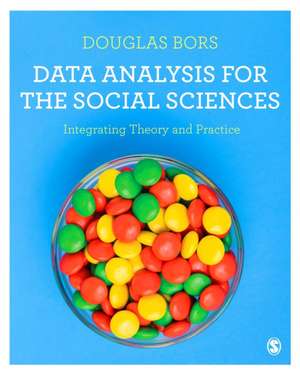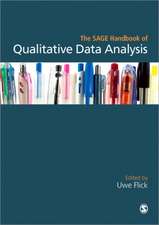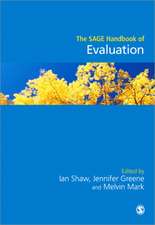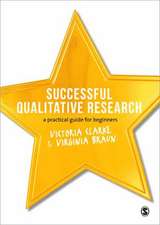Data Analysis for the Social Sciences: Integrating Theory and Practice
Autor Douglas Borsen Limba Engleză Paperback – 29 ian 2018
'This unique text presents the conceptual underpinnings of statistics as well as the computation and application of statistics to real-life situations--a combination rarely covered in one book. A must-have for students learning statistical techniques and a go-to handbook for experienced researchers.' —Barbra Teater, Social Work, College of Staten Island, City University of New York
Accessible, engaging, and informative, this book will help any social science student approach statistics with confidence.
With a well-paced and well-judged integrated approach rather than a simple linear trajectory, this book progresses at a realistic speed that matches the pace at which statistics novices actually learn. Packed with global, interdisciplinary examples that ground statistical theory and concepts in real-world situations, it shows students not only how to apply newfound knowledge using IBM SPSS Statistics, but also why they would want to. Spanning statistics basics like variables, constants, and sampling through to t-tests, multiple regression and factor analysis, it builds statistical literacy while also covering key research principles like research questions, error types and results reliability.
It shows you how to:
- Describe data with graphs, tables, and numbers
- Calculate probability and value distributions
- Test a priori and post hoc hypotheses
- Conduct Chi-squared tests and observational studies
- Structure ANOVA, ANCOVA, and factorial designs
| Toate formatele și edițiile | Preț | Express |
|---|---|---|
| Paperback (1) | 402.02 lei 3-5 săpt. | +50.57 lei 6-12 zile |
| SAGE Publications – 29 ian 2018 | 402.02 lei 3-5 săpt. | +50.57 lei 6-12 zile |
| Hardback (1) | 1109.92 lei 6-8 săpt. | |
| SAGE Publications – 29 ian 2018 | 1109.92 lei 6-8 săpt. |
Preț: 402.02 lei
Nou
76.92€ • 80.32$ • 63.67£
Carte disponibilă
Livrare economică 14-28 martie
Livrare express 27 februarie-05 martie pentru 60.56 lei
Specificații
ISBN-10: 1446298485
Pagini: 664
Dimensiuni: 186 x 232 x 42 mm
Greutate: 1.18 kg
Ediția:1
Editura: SAGE Publications
Colecția Sage Publications Ltd
Locul publicării:London, United Kingdom
Recenzii
This unique text presents the conceptual underpinnings of statistics as well as the computation and application of statistics to real-life situations--a combination rarely covered in one book. A must-have for students learning statistical techniques and a go-to handbook for experienced researchers.
Statistics textbooks are not often known for their engaging writing style, but Douglas Bors’ work is an exception. Humorous, detailed, and clearly-written, the book guides readers through both a conceptual and procedural understanding of statistics essentials. A great resource that I look forward to using in my courses.
Cuprins
Chapter 1: Overview
The general framework
Recognizing randomness
Lies, damn lies, and statistics
Testing for randomness
Research design and key concepts
Paradoxes
Chapter 2: Descriptive Statistics
Numerical Scales
Histograms
Measures of Central Tendency: Measurement Data
Measures of Spread: Measurement Data
What creates Variance?
Measures of Central Tendency: Categorical Data
Measures of Spread: Categorical Data
Unbiased Estimators
Practical SPSS Summary
Chapter 3: Probability
Approaches to probability
Frequency histograms and probability
The asymptotic trend
The terminology of probability
The laws of probability
Bayes’ Rule
Continuous variables and probability
The standard normal distribution
The standard normal distribution and probability
Using the z-tables
Part II: Basic Research Designs
Chapter 4: Categorical data and hypothesis testing
The binomial distribution
Hypothesis testing with the binomial distribution
Conducting the binomial test with SPSS
Null hypothesis testing
The x2 goodness-of-fit test
The x2 goodness-of-fit test with more than two-categories
Conducting the x2 goodness-of-fit test with SPSS
Power and the x2 goodness-of-fit test
G -test
Can a failure to reject indicate support for a model?
Chapter 5: Testing for a Difference: Two Conditions
Building on the z-score
Testing a single sample
Independent-samples t-test
t-test assumptions
Pair-samples t-test
Confidence limits and intervals
Randomization test and bootstrapping
Nonparametric tests
Chapter 6: Observational studies: Two categorical variables
x2 goodness-of-fit test reviewed
x2 test of independence
The phi coefficient
Necessary assumptions
x2 test of independence SPSS example
Power, sample size, and the x2 test of independence
The third-variable problem
Multi-category nominal variables
Tests of independence with ordinal variables
Chapter 7: Observational studies: Two measurement variables
Tests of association for categorical data reviewed
The scatterplot
Covariance
The Pearson-Product Moment Correlation Coefficient
Simple regression analysis
The Ordinary Least Squares Regression Line (OLS)
The assumptions necessary for valid correlation and regression coefficients
Chapter 8: Testing for a difference: Multiple between-subject conditions (ANOVA)
Reviewing the t-test and the x2 test of independence
The logic of ANOVA: Two unbiased estimates of o2
ANOVA and the F-test
Standardized effect sizes and the F-test
Using SPPS to run an ANOVA F-test: Between-subjects design
The third-variable problem: Analysis of covariance (ANCOVA)
Non-parametric alternatives
Chapter 9: Testing for a difference: Multiple related-samples
Reviewing the between-subject ANOVA and the t-test
The logic of the randomized block design
Running a randomized block design with SPSS
The logic of the repeated-measures design
Running a repeated-measures design with SPSS
Non-parametric alternatives
Chapter 10: Testing for specific differences: Planned and unplanned tests
A priori versus post hoc tests
Per-comparison versus family-wise error rates
Planned comparisons: A priori test
Testing for polynomial trends
Unplanned comparisons: Post hoc tests
Non-parametric follow-up comparisons
Part III: Analyzing Complex Designs
Chapter 11: Testing for Differences: ANOVA and Factorial Designs
Reviewing the independent-samples ANOVA
The logic of factorial designs: Two between-subject independent variables
Main and simple effects
Two Between-Subject Factorial ANOVA with SPSS
Fixed versus random factors
Analyzing a mixed-design ANOVA with SPSS
Non-parametric alternatives
Chapter 12: Multiple Regression
Regression revisited
Introducing a second predictor
A detailed example
Issues concerning normality
Missing data
Testing for linearity and homoscedasticity
A multiple regression: The first pass
Addressing multicollinearity
Interactions
What can go wrong?
Chapter 13: Factor analysis
What is factor analysis?
Correlation coefficients revisited
The correlation matrix and PCA
The component matrix
The rotated component matrix
A detailed example
Choosing a method of rotation
Sample size requirements
Hierarchical multiple factor analysis
The effects of variable selection
Notă biografică
Dr. Douglas Alexander Bors is currently an Associate Professor Emeritus at the University of Toronto, the institution from which he received his Ph.D. For over three decades he has taught courses in statistics at the undergraduate and graduate levels ranging from the introductory level to multivariate statistics and structural equation modelling. He is also the Dean¿s Designate for Matter of Academic Integrity. He has served as a reviewer for several scholarly journals and has been a regular reviewer for Personality and Individual Differences. During his career his empirical research focused on problem solving and abstract reasoning. The short-form of the Advanced Raven¿s Progressive Matrices that he developed with Tonya Stokes is a widely used research instrument. Over the years he has acted as a consultant for major pharmaceutical firms as well as survey and marketing companies. Currently he is retained as a design and analysis consultant for a major marketing firm.



















